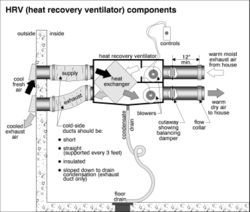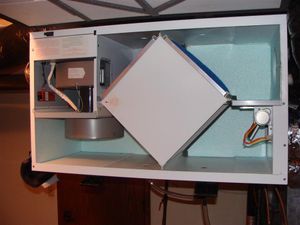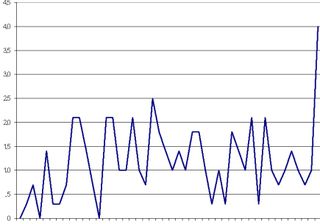On any new home built in Minnesota today, there needs to be a means of mechanical ventilation provided. The more expensive, but far more efficient way of doing this is to install a heat recovery ventilator, or HRV. I’m posting a three part series on HRVs – today I’ll share some basic information about how HRVs operate and why they’re needed in today’s newer, tighter houses.
HRVs Have Many Names If you hear any of these terms, someone is probably talking about an HRV:
- Air-to-air heat exchanger
- Air exchanger
- Whole house ventilator
- Big square thingy in the furnace room
- VanEE system (brand name)
- ERV
The last one, ERV, stands for Energy Recovery Ventilator. These are similar to HRVs, but ERVs are pretty rare here in Minnesota – I think I’ve seen two of them, ever. They’re designed for more humid, southern climates.
New Houses Don’t Breathe As most people know, new houses are constructed much tighter than they used to be – they don’t leak air all over the place. I’ve heard a lot of old-school home inspectors and building contractors complain about this, and you probably have too. The rant goes something like this: “We build houses so tight that they don’t breathe, and they end up rotting from the inside out! Things were a lot better when we didn’t have all these stupid house wraps.”
These cranky doom sayers are right; we build houses tighter today and this certainly causes problems, but we’ve also figured out how to help prevent mold and moisture problems, and how to improve indoor air quality. This is where HRVs come in.
HRVs Provide Fresh Air An HRV works by constantly bringing fresh air in to a house and exhausting stale air. The air that gets brought in to the house gets passed through a screen at the exterior, then through a filter inside the unit, then through the HRV core, which is actually a heat exchanger. The heat exchanger allows the fresh outdoor air to get warmed by stale indoor air right before the indoor air gets exhausted to the exterior. This allows about 60 – 80% of the heat in the air to be re-captured. The diagram below illustrates this principal.
To understand how an HRV works, interlock your fingers together and picture warm air flowing through fingers in one hand, and cold air flowing through the fingers in the other hand.
HRVs Remove Moisture Besides providing fresh air, HRVs also remove a lot of moisture from the air. Old, drafty houses get dry in the winter because they’re leaky, and the moist indoor air is always getting replaced with dry outdoor air. Not so with newer houses – they retain much more humidity during the winter, and HRVs are often needed just to get rid of all the excess humidity. As the warm, moist air passes by the cold air, the moisture will condense. This is why HRVs have a drain running out of the bottom.
HRVs Lower Radon Levels Because HRVs constantly change out the air in a house, an HRV will reduce radon levels when working properly. During a recent Eden Prairie home inspection that I also performed a radon test at, I had the HRV running during the majority of the radon test, but I tripped the GFCI outlet for the last hour of the radon test during my inspection. Look at the jump in radon levels at the house from NOT having the HRV running! Any time a radon test is performed, if there is an HRV present at the house, it should be up and running throughout the duration of the radon test.
Continuous exhaust fans seem to be replacing HRVs If you don’t have an HRV at your house and you think you need one, you could always install a continuous exhaust fan instead. This will be relatively inefficient, but it will change out the air in your house. I’ve always called this the ‘poor man’s HRV’… although maybe I should stop calling it that, as this has become standard practice for new construction homes in Minnesota. Continuous exhaust fans are rated for continuous use and have a lower CFM rating when running continuously, so they’re not nearly as inefficient as a standard bathroom exhaust fan running all the time.
HRVs, Part 2 of 3: Maintenance and Operation
HRVs, Part 3 of 3: Installation Defects
Reuben Saltzman, Structure Tech Home Inspections – Email – Eden Prairie Home Inspector





